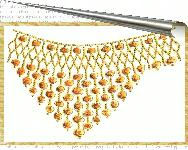Necklaces are believed to be as old as 40,000 years, during the Stone Age. The oldest necklaces were made of purely natural materials - before weaving and the invention of string, durable vines or pieces of animal sinew left over from hunts were tied together and adorned with shells, bones or teeth or colourful skins of human prey animals, bird feathers, corals, carved pieces of wood, colorful seeds or stones or naturally occurring gems, or other beautiful or artful natural elements found nearby.
#jewelleryfacts365 256/365 Gem fact
Thursday, October 13, 2016
Originally, rhinestones were rock crystals gathered from the river Rhine, hence the name, although some were also found in areas like the Alps. The availability was greatly increased in the 18th century when the Alsatian jeweller Georg Friedrich Strass had the idea to imitate diamonds by coating the lower side of glass with metal powder. Hence, rhinestones are called strass in many European languages.
Labels:
gem facts,
jewellery facts
#jewelleryfacts365 255/365
Prior to the introduction of plastics, ivory had many ornamental and practical uses, mainly because of the white color it presents when processed. It was formerly used to make cutlery handles, billiard balls, piano keys, Scottish bagpipes, buttons and a wide range of ornamental items.
Synthetic substitutes for ivory in the use of most of these items have been developed since 1800: the billiard industry challenged inventors to come up with an alternative material that could be manufactured; the piano industry abandoned ivory as a key covering material in the 1970s.
 |
| Vintage Scottish ivory bagpipes |
Labels:
jewellery facts
#jewelleryfacts365 254/365 Gem fact
The first archaeological evidence known of usage of the obsidian were made from within Kariandusi and other sites of the Acheulian age (beginning 1.5 million years previously) dated 700,000 BC
Labels:
gem facts,
jewellery facts
#jewelleryfacts365 253/365 Gem facts
Monday, October 10, 2016
Being a phosphate mineral, turquoise is inherently fragile and sensitive to solvents; perfume and other cosmetics will attack the finish and may alter the colour of turquoise gems, as will skin oils, as will most commercial jewellery cleaning fluids. Prolonged exposure to direct sunlight may also discolour or dehydrate turquoise. Care should therefore be taken when wearing turquoise jewellery. Cosmetics, including sunscreen and hair spray, should be applied before putting on a turquoise piece of jewellery. Also, you should not wear it to a beach or other sun-bathed environment. After use, turquoise should be gently cleaned with a soft cloth to avoid a buildup of residue, and should be stored in its own container to avoid scratching by harder gems. Turquoise can also be adversely affected if stored in an airtight container.
 |
| Silver ring with turquoise and sugilite |
Labels:
gem facts,
jewellery facts
#jewelleryfacts365 252/365 Diamond fact
In the time of the Pharaohs, 3000BC, a diamond was placed in the middle of the ankh – a cross with a loop on top. This was the Egyptian hieroglyph meaning life. Diamonds represented the sun, symbol of power, courage and truth.
Labels:
Ancient Egypt facts,
diamond facts,
jewellery facts
#jewelleryfacts365 251/365 Diamond fact
Only one in a million of mined diamonds ends up in jewelry.
Labels:
diamond facts,
jewellery facts
Jewellery masterpieces
Friday, October 7, 2016
 |
| Henri Vever | Opal and Diamond Pendant c1910. |
Labels:
Jewellery masterpieces
#jewelleryfacts 250/365
Chinese used diamonds and sapphires to polish ceremonial burial axes as early as 6,000 years ago. The axes, which are made from corundum (or ruby in its red form and sapphire in other colors), were polished to a mirror finish.
 |
| Diamond-polished corundum axe from the Neolithic Liangzhu culture of ancient China, ca. 2500 B.C. Photo by Peter J. Lu |
Labels:
diamond facts,
jewellery facts,
ruby facts,
sapphire facts
#jewelleryfacts365 249/365 Diamond fact
Thursday, October 6, 2016
The Hindus, who were known to use diamonds in the eyes of their statues, believed that diamonds were created when bolts of lightning struck rocks. Diamonds were also believed to attract lightning bolts.
Labels:
diamond facts,
jewellery facts
#jewelleryfacts365 248/365 Diamond fact
While diamonds are one of the hardest substances in nature (although recent research has proved otherwise), synthetic nanomaterials have been created that are much harder.
Labels:
diamond facts,
jewellery facts
#jewelleryfacts365 247/365
Some of the world's most famous diamonds, including the Hope Diamond, have been set in platinum.
 |
| Delicate by royal standards, the Pendant Brooch is home to two Cullinan diamonds, namely the emerald cut Cullinan VI and elegant marquise cut Cullinan VIII. |
Labels:
diamond facts,
jewellery facts,
platinum facts
#jewelleryfacts365 246/365
The ancient Egyptians, Central Americans and the Chinese also buried jade with their dead, usually in the mouth. Green stones were most often used, they were meant to represent the heart.
Labels:
Ancient Egypt facts,
jewellery facts
#jewelleryfacts365 245/365
Most commonly still worn today is the Irish Claddagh ring, two hands holding a heart with a crown. The Claddagh ring was first designed in the 16th century, 13 centuries after the original fede rings of Rome.
Labels:
jewellery facts
Bead Day
Saturday, October 1, 2016
 |
| Plateau artist, Vest, ca. 1920, glass beads on hide, The Elizabeth Cole Butler Collection, no known copyright restrictions |
Labels:
Bead Day
#jewelleryfacts365 244/365
Glass beads have been in use for almost five centuries in the Americas.
Labels:
jewellery facts
Subscribe to:
Posts (Atom)






































